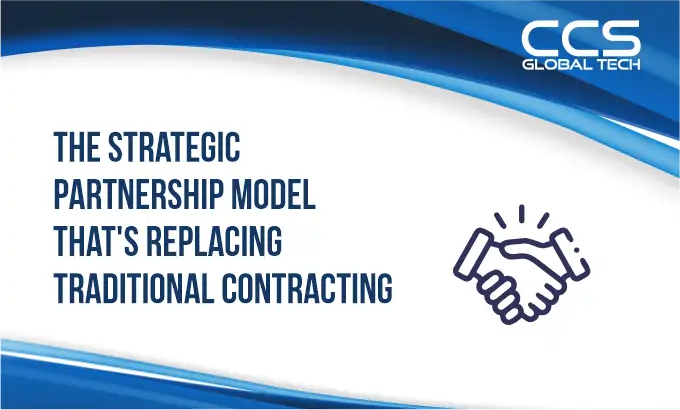The call came at 4:30 PM on a Friday.
A federal agency director had just lost her entire contract management team, three retirements in six weeks. With a critical project launching in 90 days, she asked a different question than we usually hear: “Can you help us build something that lasts?”
That conversation became the blueprint for what we’re seeing across federal agencies: a fundamental shift from transactional contracting to strategic partnership.
The Breaking Point
For decades, traditional contracting worked on a simple premise: identify needs, award contracts, get work done. Repeat.
But that model is straining under today’s workforce realities. Federal hiring timelines now average 98 days, nearly double the private sector. Combined with restrictions like the 2025 hiring freeze (one hire for every four departures), agencies face a widening capability gap.
The result? Structural strain, not short-term staffing issues. Agencies need new ways to sustain operations, deliver outcomes, and retain institutional knowledge amid shrinking headcounts.
What Partnership Actually Means?
Strategic partnership isn’t about rebranding vendor relationships. It’s a fundamental rethinking of how agencies and support organizations collaborate to sustain mission outcomes.
Here’s how we approached it with a Department of Defense logistics center:
- Instead of filling 47 open positions, we analyzed workflows.
- 60% of backlog stemmed from three specific bottlenecks.
- We placed 18 specialists focused on those areas and redesigned processes.
Result: Backlog cleared in four months with less than half the staff originally planned, at 35% lower cost. Processing times were cut in half.
We also built knowledge transfer systems – pairing each contractor with a permanent employee. When our specialists rotated out, expertise stayed behind.
And instead of fixed staffing, we introduced flexible capacity that scaled with demand: 25 specialists in peak season, 12 during slower periods.
That’s what partnership looks like in practice.
The Data Behind the Shift
We’re not alone in seeing this evolution:
- 83% of major federal departments struggle with staffing shortages (Roadmap for Renewing Our Federal Government)
- McKinsey estimates that governments in the U.S. have a productivity-improvement opportunity worth $725 billion to $765 billion by applying more efficient approaches in operations.
Our work confirms these findings. OECD–Public-Private Partnerships in the infrastructure domain report “efficiency gains” through shared risks, performance-based contracts, and innovation incentives.
The Five Pillars of Strategic Partnership
Based on our work across dozens of agencies, five elements distinguish partnership from traditional contracting:
1. Outcome focus over headcount focus
We propose results and metrics, not positions and hours. “Reduce processing time by 20%,” not “provide 10 FTEs.”
2. Knowledge integration, not isolation
Our professionals integrate into agency teams, building sustainable capability that remains after we’re gone.
3. Flexible capacity, not fixed staffing
Support scales with actual need. Clients pay for results and capacity, not seats filled.
4. Process improvement, not gap filling
Every engagement analyzes why gaps exist and how workflows can improve. Success means building agency independence, not our indispensability.
5. Long-term relationship, not project transaction
Multi-year frameworks allow for trust, learning, and continuous improvement–not 12-month resets.

Why This Matters Now?
Federal workforce decline: The Congressional Budget Office projects an 8–12% drop in federal employment over the next five years, equivalent to 200,000 to 300,000 positions.
The work remains: Services won’t decline by 12%. The mission-critical work continues, even as staffing levels shrink.
The challenge: Traditional workforce models, built on stable, growing headcounts, no longer align with today’s realities.
The solution: Agencies need strategic partners who can design smarter, scalable workforce solutions that build future-ready capacity rather than replicating outdated structures.
Real-world impact: A Veterans Affairs regional office lost 40% of its benefits counselors over 18 months.
Instead of refilling 40 roles, we redesigned their intake process. Implemented better tools and deployed specialists in key bottlenecks.
Result: Claims processed 25% faster, total staff reduced by 25%, and veteran satisfaction scores improved. (Report)
What Leaders Should Ask?
Questions that separate partnership opportunities from traditional contracts:
- Are we trying to replicate our old staffing model, or redesign how work gets done?
- Do our requirements specify positions to fill, or outcomes to achieve?
- Are we evaluating vendors on their ability to provide bodies, or solve problems?
- Does our contract structure allow flexibility, or lock us into fixed commitments?
- Are we building relationships that improve capability, or repeatedly starting over?
The answers reveal whether you’re ready for partnership– and help us determine whether we can deliver the value you need.
The Path Forward
She told us: “I used to dread losing people because it meant falling behind. Now I know we have a partner who helps us adapt and improve. That changes everything about how I lead.”
This partnership approach has succeeded across 35 federal agencies over two years– cybersecurity, claims processing, emergency management. The common thread isn’t the type of work. It’s the relationship.
The opportunity: Maintain mission effectiveness with smaller teams, build sustainable capability, and create resilience that survives hiring freezes, retirement waves, and budget uncertainty.
The risk of traditional contracting: Declining capacity, increasing costs, and workforce structures that can’t adapt to modern government operations.
The choice isn’t complicated. But it does require rethinking decades-old relationships.
Conclusion: Rethinking What Partnership Means
The future of the federal workforce isn’t about hiring more, it’s about building smarter.
Agencies embracing strategic partnerships are proving they can do more with less, maintain readiness, and strengthen institutional capacity even amid hiring freezes and budget constraints.
At CCS Global Tech, we help agencies navigate workforce transitions through flexible, results-driven partnership models that sustain mission impact long after contracts end.
If your organization faces workforce challenges that traditional contracting hasn’t solved, let’s explore how a partnership approach can help you build what’s next.
FAQ
Q1. How is the strategic partnership model different from traditional government contracting?
A: Traditional contracting focuses on filling positions and tracking hours, while strategic partnerships emphasize outcomes, shared accountability, and long-term capability building. The goal is to create lasting impact, not short-term staffing solutions.
Q2. Why are federal agencies shifting toward strategic partnerships?
A: Agencies are adopting partnership models to overcome staffing shortages, increase agility, and improve mission outcomes. These partnerships allow flexible scaling, process innovation, and knowledge retention that traditional contracts can’t deliver.
Q3. What measurable benefits do strategic partnerships provide to agencies?
A: Agencies report faster delivery times, lower long-term costs, better data integration, and stronger workforce sustainability. Unlike transactional contracts, partnerships create continuous improvements that compound over time.
Q4. How do strategic partnerships improve workforce resilience?
A: Partnerships embed external specialists into agency teams, ensuring skill transfer, reducing dependency on contractors, and preserving institutional knowledge. This strengthens operational continuity during hiring freezes or retirements.
Q5. What challenges can agencies face when transitioning from contracting to partnership models?
A: The biggest hurdles include shifting from a compliance-driven to a performance-driven mindset, updating procurement frameworks, and building trust between internal teams and partners. Clear metrics and transparency help ease the transition.
Q6. How do outcome-based partnerships drive efficiency in federal operations?
A: By focusing on measurable objectives, like reducing processing time or improving data accuracy, outcome-based partnerships align incentives between agencies and partners, eliminating waste and promoting accountability.
Q7. What role does knowledge transfer play in strategic partnerships?
A: Knowledge transfer ensures that expertise gained through external collaboration stays within the agency. It builds self-sufficiency, reduces future costs, and creates a sustainable learning ecosystem.
Q8. How do long-term partnerships impact agency innovation?
A: Long-term partnerships create space for experimentation, pilot programs, and continuous improvement. Over time, this fosters a culture of innovation where both partners and agencies co-develop smarter, more resilient systems.
Q9. Can strategic partnerships reduce dependency on contractors?
A: Yes. Instead of perpetuating reliance, these models upskill internal teams and establish co-delivery structures. The outcome is a reduced dependency on external staffing and stronger in-house capability.
Q10. How can agencies begin adopting a strategic partnership model?
A: Start by identifying mission-critical areas where outcomes matter most, then pilot flexible, results-based engagements with trusted partners. Track performance metrics, knowledge transfer, and ROI to refine the model for broader implementation.






